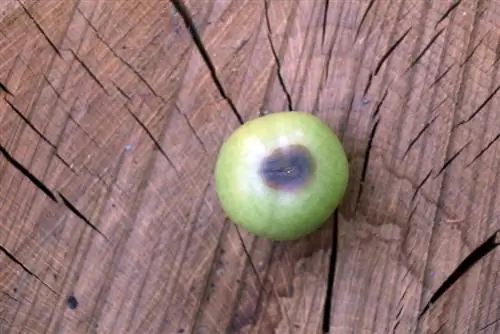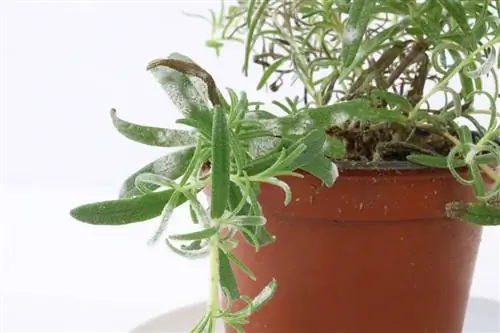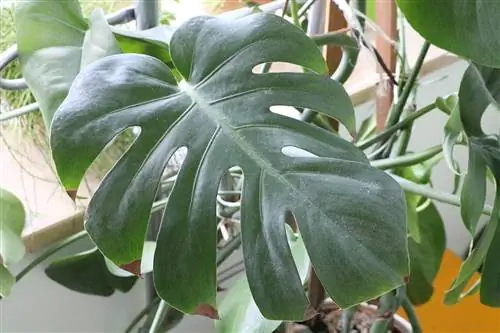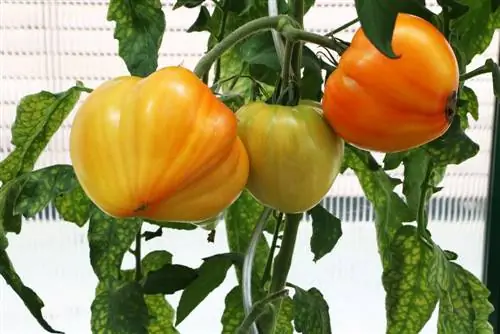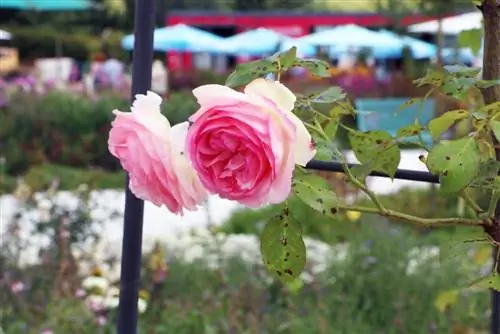- Author admin [email protected].
- Public 2023-12-17 03:39.
- Last modified 2025-01-24 12:45.
If the tomatoes show brown discoloration in the area where the blossoms start, then blossom end rot is often the culprit. This is not an infestation with pests or fungi, but rather a disease that damages the tomatoes' metabolism. The causes of blossom end rot have not yet been thoroughly researched and fully clarified, but there are good results in treating the disease. The results achieved so far at least point to certain solutions for effective prevention.
malicious image
The tomato fruits first appear watery spots at the base of the flowers and then turn dark. The flower bases are located at the bottom of the fruit, directly opposite the base of the stem. But the leaves can also be affected by blossom end rot, which is shown by malformed shoot tips. The regrowing leaves cannot develop properly and die quickly. However, not every tomato variety reacts the same way to the disease, so the appearance can vary significantly.
- Grey-green to dark brown spots
- Little by little, the spots in the fabric become larger
- Finally, the tissue sinks completely and hardens
- In rare cases, deformities appear at the tips of the shoots
- Young leaves are severely deformed and grow poorly
Causes
When the first signs of blossom end rot appear, incorrect irrigation may be to blame. Even if the tomato plants receive too few nutrients, they are more susceptible to the metabolic disease. In addition, the pH value and the concentration of nutrient s alts in the soil play an important role, including ammonium, potassium, magnesium and sodium. The calcium supply is also an important factor; acidic and permanently too dry soils cause deficiencies, as calcium is mainly absorbed through the irrigation water and can thus get into the fruits.
- Severe fluctuations in casting units are often a cause
- Inadequate nutrient supply
- Too acidic soil supports the progression of the disease
- Blossom end rot is more common on greenhouse tomatoes
- Strong and lush growing tomato varieties are particularly at risk
Combat & Prevention
The tomato plants need regular, but not excessive, watering. Especially during long dry periods, the watering units are extremely important in order not to unnecessarily weaken the plant's immune system. Furthermore, fertilizer doses are an important factor in maintaining he alth, as is the content of nutrient s alts. In order to take the right preventive measures, soil tests are advisable, as these can provide precise information about the facts. You can easily determine the pH value of the soil yourself; you can get a kit for the test from specialist retailers. This can be used even without chemical knowledge, thanks to the coloring reaction the gardener can see how high the lime content of the soil is.
- Soil must be neither too dry nor too wet
- It is optimal that the soil is evenly moistened
- Ensure a balanced supply of nutrients
- Avoid oversupply of nutrient s alts such as magnesium and potassium
- Check the pH value of the soil regularly
- Ideal soil pH is 6.5
- Neutralize soils that are too acidic by adding lime
- Alternatively, work rock dust into the soil
Tip:
If problems with blossom end rot or other diseases occur repeatedly, then a detailed soil analysis by a specialist laboratory is recommended. This can be carried out, for example, with the help of the LUFA (Agricultural Research and Research Institute), with appropriate fertilizer recommendations if desired.
Fertilizer
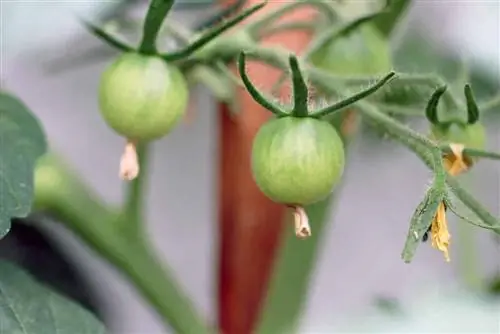
If tomato plants receive too few nutrients, they are particularly susceptible to blossom end rot. In this case, regular fertilization is recommended, but in the right amount to avoid under- or over-supply. Over-fertilizing the soil with a fertilizer that contains too much nitrogen is also one of the possible causes of the disease. Specialist retailers offer special fertilizers that are tailored to the specific needs of tomatoes. If the first symptoms appear on the fruits, then an effective calcium fertilizer that is absorbed through the leaves is suitable.
- Fertilize tomato plants as needed
- Organic natural fertilizer with long-term effects is ideal
- Spray calcium fertilizer on the leaves
Edibility
The affected tomatoes are first noticed by small spots on the flower bases that are somewhat watery. These spots gradually enlarge, causing the tissue to sink and become unsightly. It then dries and hardens. Based on most experience, the damage often only shows up sporadically on the tomato fruits. In most cases, not all tomatoes on a panicle or all panicles on a diseased plant are affected. The still he althy fruits can be eaten without any problems, but the diseased areas should be removed before consumption. Normally there is no impact on the taste as the inner pulp remains largely intact.
- Affected tomato fruits can be eaten safely
- Cut off any rotten areas generously before consumption
- If the disease has progressed too far, remove infected tomatoes completely
Conclusion
If the garden is used to cultivate crops, then these should be checked regularly. In this way, diseases can be detected early and the harvest can be secured. Blossom end rot can quickly occur in tomatoes if the watering units, soil quality and nutrient supply are not correct. In order to permanently prevent blossom end rot, it is therefore important to water the soil sufficiently and evenly and to fertilize it as needed. In addition, it must be supplied with enough calcium. If some tomato fruits are already affected and show the first signs of discoloration, they are still suitable for consumption. However, the discolored areas must be cut off generously; the flesh inside the fruit is usually still intact.

